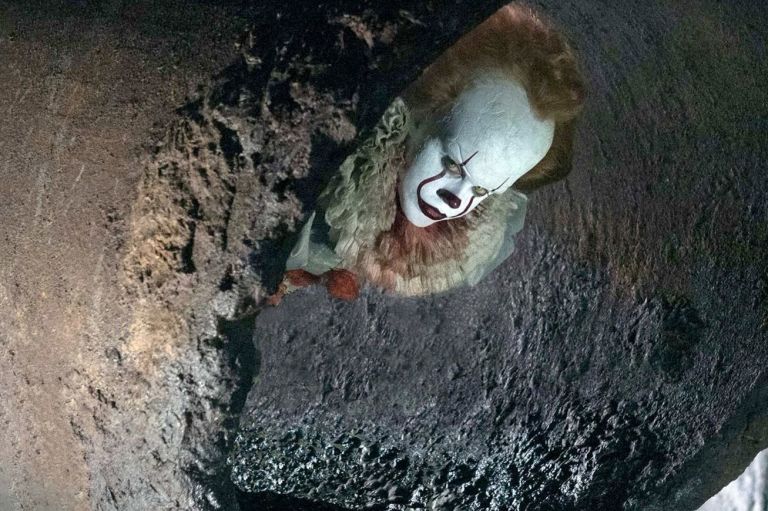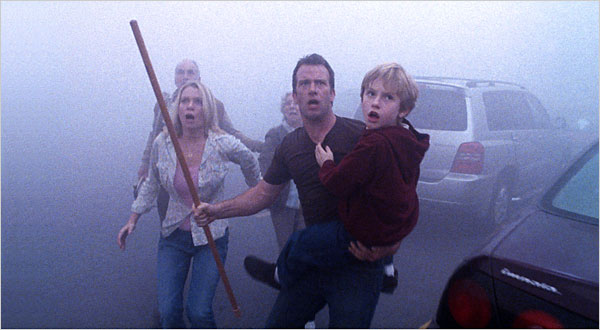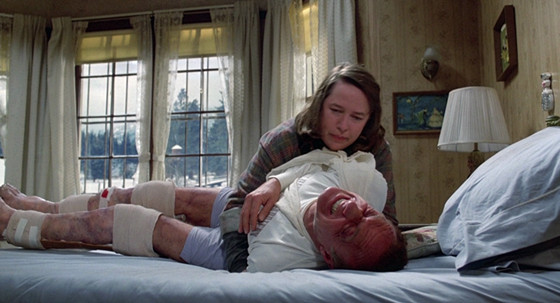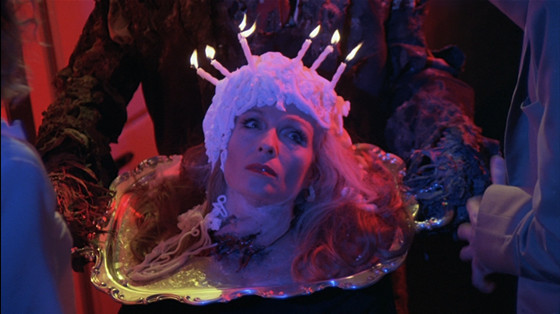5. Christine

John Carpenter is a perfect match for Stephen King. Their styles are so perfectly in line that it’s insane that they haven’t done more together. They were going to, with Carpenter supposed to tackle Firestarter, but that fell apart.
The closest they would ever come together again was when Carpenter made In The Mouth of Madness, an HP Lovecraft/King esque horror movie. They both have a blue collar aesthetic that doesn’t mean low class or messy. They both have immense technical craft in their fields and they use it to really heighten the power of their stories.
Carpenter is one of the most technically accomplished directors ever, the filmic equal to King’s prose. And a story about a killer car was going to need an accomplished director to make it work, as this is a story that was very capable of becoming a joke. But Carpenter did it, adding another classic to his unprecedented winning streak in the 70s/80s.
His camera and his score manage to make that red beast a haunting presence. It feels alive and menacing. In one of the most iconic images in Carpenters filmography, he has the car catch fire and still chase after a bully, that flaming behemoth searing itself into an audiences memory. Like the best of King’s work, there is more to this than just a killer car. It’s a story about addiction. The addictive nature of power and how corrupting it can be when the powerless get power.
When nerd Arnie comes into possession of this car (or vice versa?), he starts to change. He starts to become more and more like the bullies that have tortured him all his life. This car gives him power and it ruins him. And Carpenter gets to the heart of that. He really nails all of that, thanks in no small part to the fantastic performance by Keith Gordon as Arnie.
Christine is one of the best books King has written, yet the nature of the story makes it one of the most difficult. Carpenter nailed it and gave the world one of the best and most faithful King adaptation ever that still feels like Carpenter.
4. It

The most unlikely entry on this list, if only because the story it is adapting is a massive behemoth of a novel that makes the idea of crunching it down into one movie is a bad idea. That and it was also made into a supremely mediocre TV miniseries that 90s babies can’t let go. But this movie is a miracle and it all stems from one simple fact. They split the novel in two.
The story itself is split between two different time periods, so there was a built in way to split the story without making each movie feel incomplete. So this movie having a runtime over two hours gives them plenty of time to let this half of the story breathe and come to life. The characters are allowed to feel real and lived in so we care about them. Pennywise is built into a real scare machine, a new generation version of Freddy Kruger.
The story is hinted at but enough is withheld as to let the sequel really delve deep into the mythology, the withholding a natural storytelling element as these kids wouldn’t have all the info since they’re kids and all. It’s a scary thrill ride, elemental in it’s fear and truly feeling like King’s Opus brought to screen. It is just tangibly rich and filled to the brim with things that brought us all to this book.
It is one of the most true to King tonally that we have ever seen. It’s an immense movie and the world has connected, making it the most successful horror movie ever (close to first with inflation too). This may very well be placed higher when the second one comes out. If it sticks the landing, this will be higher. As is, it’s gotta deal with only being 4th place.
3. The Mist

Frank Darabont is maybe the best at getting King’s material on to screen intact. It’s either him or Rob Reiner, but he’s 3/3 with King’s work. But this is the only horror movie he’s made of his work and it is arguably the best one he’s made. If there is one thing that Darabont has done in these adaptations is change things for the better. Either by adding or subtracting or compacting, he is able to wrangle the story to become cinematic in it’s faithfulness to King.
Here he takes the bottle episode-esque story from King about a group of small town Maine residents locked away in a supermarket as a mysterious mist descends upon the town (world?). There’s monsters in the mist, but the real monsters are inside the store. This is a story about tension, about people crashing against one another in a super tense scenario and the danger that comes about from such a scenario.
In an unknowable situation, the cowardly and easily led want answers. And if someone, no matter how crazy they may be, claims to have answers? Bad things will happen. Another critique of extremism in organized religion, The Mist is a tense as hell story and Darabont nails that tone to a T. He gathers a great cast and allows them to bounce off each other to the point of danger. We get to know these people in this hellscape. So everything plays out naturally, even if the brutal way people are knocked off the board can still surprise us.
But being a movie and being made by a film freak of a certain age, Darabont wanted to really heighten the monster movie elements to feel like an updated telling of a 1950s monster movie. And he does it. These differing visions don’t clash at all. If anything, they compliment one another.
It’s definitely even better in Darabont’s preferred version, which is in Black and white. But what really makes this one of the best King adaptations, besides being thrilling as hell and completely in tone with King, is that ending. King’s original novel ends on an ambiguous note, with no real ending in sight. Things are left up in the air. Darabont realized they wouldn’t fly and decided there was a better ending for this story.
A story filled with despair and the brutal lengths we are willing to go to survive and protect our loved ones. There’s no need to spoil it here if you haven’t seen the movie, but it’s no lie to say it is one of the most nihilistic and depressing endings ever. It’s rough. But it’s perfect. So perfect that even King says he wished he came up with that ending for the novella, as it is much better than the one he made. In a career where he has taken Kings work and made them better for the screen, this may stand as the best. A horrific on many levels horror movie that is layered in its mastery.
2. Misery

As mentioned earlier, Rob Reiner is in contention for the best adaptor of King’s work. Stand By Me is a masterpiece, a classic of cinema and the second best movie in the King canon. But it isn’t horror. Reiner’s second King adaptation is horror and it’s just as masterful. Another one of these locked room thrillers that has characters bounce off each other to reveal their true selves, it is horrific.
An early look at the horrible ways fandom can ossify and be poisonous to creators, it has aged quite well sadly. When horror novelist (of course) Paul Sheldon gets into a car wreck, he is saved by Paul Sheldon superfan Annie Wilkes. She takes care of him in her house, but things start to reveal themselves to be more dangerous than initially thought. Annie is clearly deranged and is going to use Paul to resurrect the character she has connected too so strongly. What follows is a battle of wills that culminates in death and mayhem.
This movie is no typical horror movie, but the tension can be cut with a knife. And it has one of the most horrific scenes ever. The hobbling scene. It’s a well shot movie, dynamic the way it makes it’s one locale never look boring or one note. But this movie is like a play, so the acting has to be masterful.
There’s only two real roles here, and they are great. James Caan is fantastic as Sheldon, revealing levels of pathos and weakness that he’s never shown before in his tough guy career. But the star is Kathy Bates as Misery, an award winning performance for the ages. She is a monster and the levels she brings here are astounding.
The movie wouldn’t work without her to terrorize Caan. This movie still works today thanks to it’s simple hook and it’s reliance on human beings. Nothing has aged poorly. If anything it has gotten better with age, it’s layers becoming more relevant and more prescient. It’s a masterful movie and one that will be hard to beat for years to come.
1. Creepshow

George Romero’s first outing with King is the best of the bunch because it is a truly one of a kind entry in both of their canons. It’s an anthology film that is a little bit horror, but mostly comedic. Blackly comedic, but comedic nonetheless.
Romero has never been one too reliant on comedy in a career of horror movies, and King’s cinematic work tends to lean towards the horror. So for these two guys to come together to make a feature length love letter to the EC Comics of their youth was lightning in a bottle. A visual treat that showcased a flair for eye popping visuals that Romero has never shown before, going for more down to Earth visuals in his career.
The tone is a real balancing act, one that has to have real stakes but also be so absurd that we can’t help but laugh at the sheer lunacy on display. There’s the reliance on gross practical effects work that helps tie it into that EC tone, of supremely gross work. Monsters and blood and all that fun stuff. Fun is the word of the day here. It’s so watchable and so fun that it breezes by.
It’s a perfect little movie that just captures the essence of these two storytellers perfectly. It’s a shame there has never been more to this, as it’s only had one mediocre sequel and nothing else. It’s tailor made for constant returns. Be it sequels or a tv show. But as it stands, it’s a perfect movie and one that is the high watermark for these guys. Especially for King on screen.
Author Bio: Tom Lorenzo is from Long Island, he’s NY’s most preeminent pop culture fanatic. If it’s a western or a horror movie, he wants to see it. No argument is too minuscule or flawed for him to go full force with.